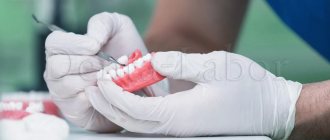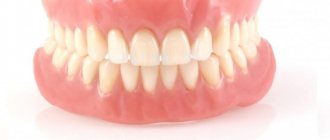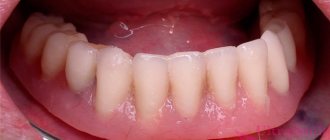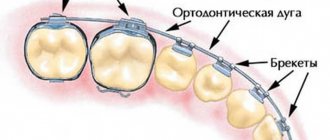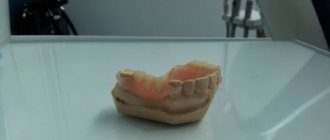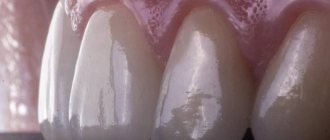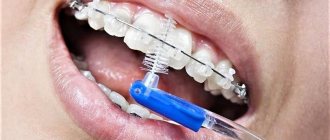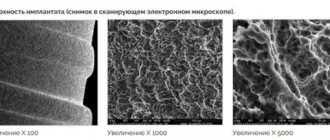- When is denture relining necessary?
- Contraindications for prosthesis relining
- Laboratory relocation
- Relining the prosthesis price
- Features of the clinical method
- Laboratory method for relining a prosthesis
Attachment of removable dentures during prolonged wear with intense loads loses functionality.
Gradual weakening of locks or hooks requires relining of the removable denture. It is not difficult to determine that you need to contact a specialist for help. During a conversation or eating, gradually progressive discomfort begins to appear. Relining the removable denture will ensure a tight fit of the structure and will completely normalize the bite. By postponing a visit to the orthodontist, people expose the oral mucosa to danger and the likelihood of injury increases.
Symptoms that should not delay a visit to the dentist
You should make an appointment with an orthodontist if:
- changes in the alveolar process of the upper jaw appear;
- the prosthesis has received damage that is not visible to a specialist, or significant flaws have appeared after prolonged wear;
- the height of the lower third of the face has undergone atypical changes. At the same time, the minimum initial deviations rapidly increase;
- The relief of the oral mucosa changes dramatically during prosthetics or after prolonged use of a stationary prosthesis.
When is denture relining necessary?
After fixing the new orthopedic system, after the first 1-3 months
wearing, relining the denture is necessary to correct the accuracy of its fit to the mucosa. Because the teeth were missing for some time, the jaw joint was rebuilt. After installing the prosthetic structure, the load on the jaw tissue changes. It begins to gradually atrophy, the gums sag, and the bite begins to change. The prosthesis becomes uncomfortable and the occlusion is disrupted.
Relocation shown:
- if the structure does not hold well in the mouth, falls out during conversation, eating, or puts pressure on the gums;
- in the presence of defects in the prosthetic system due to violations of technology during impression taking or manufacturing;
- deterioration of the aesthetic characteristics of the structure;
- the prosthesis has been damaged or has flaws;
- the shape of the alveolar process has changed, which caused instability of the orthopedic structure;
- an atypical change in the height of the lower part of the face was detected (even if the deviation is minimal from the original parameters).
Correction is needed not only for removable models, but also for conditionally removable structures supported by implants. Mostly, these are single-stage protocols with instant load (all-on-4, all-on-6). After implantation of implants and installation of a prosthetic system, the load on the bone increases. This leads to enhanced regeneration of bone tissue and an increase in its parameters, which requires correction of the orthopedic apparatus. That is, if the bite changes, the position of the prosthetic system changes.
Contraindications
Relining a removable denture is not done if:
- damage to the structure occurred due to a strong impact on a hard object or other mechanical impact that violated the integrity of the system;
- the prosthesis no longer meets the standards necessary for its continued wearing due to loss of integrity;
- there are one or more broken elements;
- anatomical retention is impaired, in which the prosthetic bed is not able to hold the prosthesis;
- The structure is unstable and can fall apart into its component parts at any moment.
The above reasons indicate the futility of relining a removable denture, since urgent production of a new system is required.
Indications and contraindications for the procedure
Indications for relining the upper and lower dentures are the following situations:
- there are visually noticeable damages and defects on the surface of the structure,
- the alveolar process has changed shape, which is why the prosthesis is unstable and has weak fixation,
- the lower third of the face has undergone changes in height (even if minor deviations are detected),
- The print was made at a low level of quality; technical defects were revealed during operation.
That is, you need to apply for relining in situations where the prosthesis has become uncomfortable - it puts pressure on the gums or does not fit well.
Relining is not carried out if there are pronounced inflammatory processes in the oral cavity of various origins (with minor inflammation of the mucous membrane, allowing for impressions to be made, relining is permissible), if there is an allergy to the materials used (in this case, the prosthesis needs to be changed), as well as the detection of obvious significant damage prosthesis or its instability - these factors are grounds for its disposal and the manufacture of a new device.
Advantages of the Denta-Labor team
- Many years of experience More than 20 years in the dental services market
- Modern equipment Expert class dental devices
- Denta-Labor's own training center conducts training courses for dental technicians in Moscow
- Individual approach The client’s wishes and existing orthopedic problem are taken into account
- No unnecessary additional services Completion of work according to a pre-agreed estimate
- Courier delivery We will deliver the dentures as soon as possible
How to clean dentures and remaining teeth
You need to brush your teeth exactly as you are used to: in the morning, in the evening and after every meal. But as for prosthetics, the recommendations will be as follows:
Daily care
- clean the structure in the morning and evening with a soft toothbrush using toothpaste without abrasives or regular soap (preferably baby soap). Pay special attention to the internal area that is in contact with the gum,
- Soak the denture daily in a solution of citric acid (1 teaspoon per 150 ml of warm water): soak it for 10 minutes to disinfect and loosen plaque. Carry out the procedure before brushing your teeth 2 times a day. Afterwards, rinse thoroughly with water. Change the solution every 3-5 days,
- after each meal, the structure is removed and thoroughly rinsed under running water,
- Additionally, you can use an irrigator, which will clean the microscopic gaps between the crowns of the structure,
- Be careful when brushing your teeth, especially if there are small parts - hooks, clasps, so as not to damage them.
Periodic care
- soak in a disinfectant solution - for this you need to purchase special tablets for removable dentures (Protefix, Corega, Lacalut Dent). Use up to 3 times a week while maintaining daily hygiene. Use according to instructions (keep in solution for 15-20 minutes),
- use products that suppress the activity of oral microflora (especially important several years after the installation of dentures, since more plaque accumulates on them). For example, “Tantum Verde” (spray, lozenges) - relieve inflammation and tension, freshen breath.
Modern equipment - ultrasonic sterilizers - can be used to disinfect dentures. They allow you to achieve ideal cleanliness of artificial teeth at home, cleaning them from bacteria and plaque. These devices can also be used to disinfect any other items - toothbrushes, baby bottles, etc.
Relocation technique
Orthodontists use two main types of denture relining.
- Clinical . It is limited by the patient’s intolerance to certain synthetic components that cause allergies, or chronic diseases of the oral mucosa.
- Laboratory . The most secure, reliable, convenient.
Only the attending physician chooses a technique based on the patient’s current condition, associated issues, and clinical picture.
Types of materials for correcting minor disorders
To restore a dental structure, three groups of materials are used:
- permanent hard: this is a plastic for relining removable dentures, available in two types - cold-curing acrylic and hot-hardening acrylate. Cold-curing acrylic can injure the mucous membrane, has an unpleasant taste and leads to discomfort in the mouth. Hot-cured resin is safer on soft tissue, but increases the likelihood of loss of structural stability. Duration of operation is 2-4 years,
- semi-permanent soft: represented by silicone and acrylic elastomers. Used when all design parameters are normal, but the patient feels discomfort and pain in the head. Most often, semi-permanent soft relining materials are used on the lower denture. Among the disadvantages of silicone, it should be noted: difficult adhesion to the base of the product (which requires the use of adhesive) and an increased risk of developing stomatitis. The downside of acrylic gaskets is a gradual loss of elasticity. The service life of cushioning materials of this group is, on average, six months,
- temporary soft (conditioners): used for soft relining of dentures in case of periodic inflammation of the mucous membrane when it is impossible to completely refuse to wear the structure. Tissue conditioners are designed to reduce and evenly distribute stress on damaged areas of the gums until they heal. They are particularly soft and can retain their properties for up to two weeks. If necessary, soft temporary materials are renewed, since they are characterized by increased sensitivity to cleaning agents and the ability to accumulate pathogenic microorganisms.
DENTAL PROSTHESIS ON 4 IMPLANTS - from RUR 170,000.
The price includes all procedures for installing Osstem implants (South Korea), including anesthesia and diagnostics.
Hurry up to sign up for a free consultation and fix your prices.
Call now or request a call
Opening hours: 24 hours a day - seven days a week
Of course, the laboratory method is always better - in the presence of professional equipment (furnaces, articulators) and materials, the dental technician will be able to correct the design as correctly as possible. It will be more comfortable, aesthetically pleasing and durable. But you, as a patient, will have to go without teeth for several days.
Relocation cost
| Name | Price from | |
| Relining a partial denture | excluding cost of prints | 5500 rub. |
| Relining a complete removable denture | excluding cost of prints | 5500 rub. |
| Repair of acrylic prosthesis | simple, excluding the cost of prints | 3000 rub. |
| Repair of acrylic prosthesis | average, excluding cost of prints | 3000 rub. |
| Repair of acrylic prosthesis | complex, excluding the cost of prints | 3000 rub. |
| Taking impressions | Complex | 2000 rub. |
Which prostheses require correction?
The main goal of this procedure is to improve the density of contact between the device and the tissues of the oral cavity, as well as to restore the physiologically correct closure of the jaws. Thus, relining allows for rational distribution of pressure on the mucous membrane.
Relining is carried out with removable structures, as well as conditionally removable ones, which are fixed on implants (mostly we are talking about immediate loading protocols, when the structure is placed immediately after implantation). All other prostheses are securely fixed and there is no need to adjust them.
conditionally removable dentures
Features of the clinical method
- Complete examination of the oral cavity, checking the integrity of the prosthesis.
- After analyzing the bite, the size of the marginal area is adjusted. The long one is cut off. Short - extended using quick-hardening plastic substances.
- A small layer of 1 mm will be removed from the prosthesis. The edge fragment loses polishing.
- Thorough impregnation of artificial elements with Vaseline.
- The boundaries of the marginal area are completely treated with a liquid polymer mixture.
- After the outer layer becomes dull, the prosthesis is put on by the patient. It is necessary to close your jaws tightly and hold in this position for a couple of minutes.
- The system is then polymerized in special equipment.
- After ten minutes of treatment, the prosthesis is removed to be adjusted manually. In the finale, he is immersed in hot water.
The advantages of clinical relining of a removable denture include the rapid elimination of existing deficiencies, as well as ideal accuracy. The disadvantages include the high porosity of the material, which reduces the hygiene of the system, and color changes.
How can I make it easier for myself to adapt and get used to a lower removable denture?
If the denture is very poorly fixed on the jaw and dangles, if the jaw is flat and there is nothing for the denture to grab onto, then you can use special means to improve the fixation of the removable denture. These are various adhesives and gaskets.
Many patients do not wear their dentures all the time, and they especially often take them out at night. There is no such need; to get used to it, it is better to wear the prosthesis around the clock. Nothing bad can happen at night, the prosthesis simply cannot be swallowed or choked on, it is much larger than a person’s throat. In the worst case scenario, you may wake up and the denture is not in your mouth, but lying next to you on the pillow. You shouldn’t take breaks during the day either, even if your jaw and gums are tired, you want to rest. At this moment, when you remove the prosthesis, the jaw and mucous membranes become unaccustomed to the prosthesis, and when an hour later you put it on again, everything starts all over again. At the same time, the jaw and mucous membranes become even more tired. Often, patients who take breaks simply stop wearing such a prosthesis after a few days.
Relining of removable dentures using the laboratory method
- The work is performed by a technician in a laboratory.
- The degree of wear of the prosthesis, quality of manufacture, and tightness of fit in the mouth are assessed.
- A control impression is made for transmission to the doctor.
- The surface of the prosthesis undergoes special treatment.
- A copy of the impression and the system are lowered into a ditch, after which they are filled with diluted plaster.
- The cast is taken out, and the resulting void is filled with polymerizing plastic.
- The excess is cut off, after which the product is polished.
The main advantages of the laboratory technique include the absence of contact between the mucous membrane and the plastic, a strong connection between the old and new layers, and an excellent aesthetic appearance. The disadvantages include the length of the process. The patient is forced to go without a prosthesis for several days; errors are possible that require additional time to eliminate defects.
Laboratory method
Work in the laboratory is carried out in cases where the prosthesis is manufactured for the first time and in cases of serious violations committed during manufacturing. And also with reduced bite heights. In this case, harmful toxins do not affect the mucous membranes of the mouth, and the product looks more aesthetically pleasing than with the clinical method.
Relocation stages:
- The prosthesis is removed and sent to the laboratory, where the top layer of plastic is removed.
- New dental impressions are taken from the patient.
- The old denture and the new impression are placed in a mold into which the plaster mixture is poured.
- The impression is then removed and the space is filled with a polymer material that bonds to the item.
- At high temperatures, the applied material polymerizes.
- The finished structure is removed, cleaned of excess and polished.
- The prosthesis is tried on the patient. If necessary, the bridge is adjusted again.
- If a person does not experience discomfort during installation, chews easily, closes his jaws, the relining is completed.
Relining is carried out using hot polymerization plastic
The big disadvantage of this method is the length of the wait and the need to visit the doctor several times. Production time takes from two to five days.
Frequently asked questions - answers:
Which prosthesis is better to choose - domestic or imported?
Perhaps, from an aesthetic point of view, our products are inferior, but in practice they turned out to be much stronger and more reliable than imported dentures.
Why is the denture, which I have been using for less than a year, constantly getting in the way and falling out? This has already begun to cause psychological discomfort.
The implant was simply not adjusted to the end. We advise you to do a relocation; do not worry, there is nothing painful or scary in this procedure.
Why do I need to reline the prosthesis if nothing bothers me?
Reliable fixation of the prosthesis is an extremely important condition for the full functioning of the entire dental system. And, of course, comfort. Any artificial teeth need to be looked after - cleaned and regularly shown to an orthopedic dentist.
To order denture relining in the dental laboratory Denta-Labor, send a request from the website or call the number: +7(495) 162-08-25.
Dyatlov Evgeniy Valerievich
Head of the Denta-Labor laboratory and teacher at the training center organized at the laboratory.
Graduated from Stavropol Basic Medical College.
Author of the article: Scientific team of the dental laboratory Denta-Labor
- Studied in Germany with Dr. Karl Peter Meschke in the course of complete removable prosthetics.
- I attended a course of lectures at the German Dental Academy based at BEGO (Bremen).
- Completed a week-long internship in Germany at the BEGO company on new technologies and materials for removable prosthetics.
Necessity of the procedure
Violation of planting density is a factor that provokes negative consequences. Firstly, lack of balance can cause damage to the replacement device, making it unsuitable for further use. Secondly, constant contact of solid elements with the mucous surfaces of the oral cavity leads to the development of inflammatory processes that will require additional treatment. Similar situations occur not only when wearing removable products, but also when installing implants - the redistribution of pressure on the tissue stimulates the regeneration process, changing the initial relief.
Reviews
— Albert
I really liked the level of service and attitude of the staff.
- Eugene
They saved me, there’s no other way to put it. Thank you for the speed and decency. Everything as promised!! I recommend to all!!!
- Svetlana
This is not the first time we have used denture repair services. As always FAST AND HIGH QUALITY! Thank you for your promptness and understanding!!
— Ksenia Vladimirovna
My daughter’s denture broke on the eve of her wedding, I was very upset, but Denta-Labor managed to fix it very quickly and efficiently, thank you.
General overview
Technically, relining a removable denture is a whole complex of actions, the priority goal of which is the restoration of the functional parameters and characteristics of the structure. In some situations, adjustment is required already early after installation, which is caused by atrophic changes in the structure of bone tissue. Chewing load after a long pause can lead to deformation of certain areas of the alveolar process, which is why doctors recommend quarterly scheduled examinations in the first year after surgery.
Delivery areas:
- Altufyevo
- Bibirevo
- Biryulyovo East
- Central Administrative District
- Chertanovo
- Golyanovo
- Krasnopresnenskaya
- Kuntsevo
- Kuzminki
- Odintsovo
- Lyublino
- Medvedkovo
- Mitino
- Otradnoe
- Pavshinskaya floodplain
- Printers
- Polezhaevskaya
- River Station
- Ryazan Avenue
- SAO
- Northern Butovo
- Sokolniki
- NEAD
- SZAO
- Tushino
- Southern Administrative District
- SEAD
- South-Western Administrative District
- Voikovskaya
- Vykhino
- Company
- Zhulebino
- Aprelevka
- Dubki
- Krasnoznamensk
- Krylatskoe
- Cuban
- Nazaryevo
- Barvikha
- Vlasikha
- VNIISSOK
- Vnukovo
- Larks
